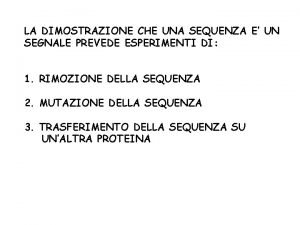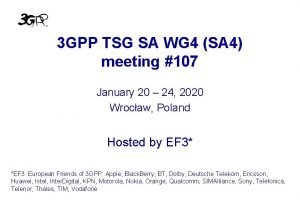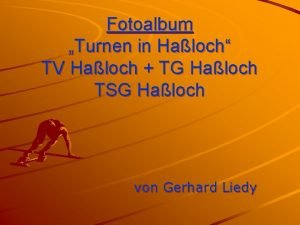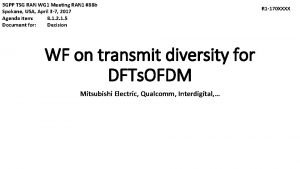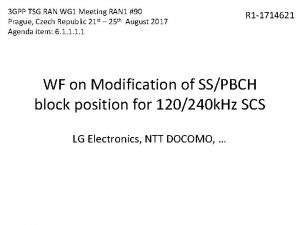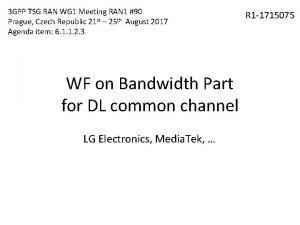3 GPP TSG RAN WG 1 Meeting 88




- Slides: 4

3 GPP TSG RAN WG 1 Meeting #88 bis Spokane, USA, April 3 rd -7 th, 2017 Agenda item: 8. 1. 2. 3. 1 R 1 -17 XXXX WF on Schemes of Partial Channel Reciprocity Huawei, Hi. Silicon, […] 1

Background The following agreements were achieved in RAN 1 88 • Update the RAN 1 Jan. Ad hoc agreements as follows; • Study the following DL CSI feedback for different degree of channel reciprocity, • For full channel reciprocity • Explicit interference feedback: e. g. , Interference covariance matrix, diagonal elements of interference covariance matrix • Implicit interference feedback: e. g. , Interference PMI feedback • Explicit channel feedback: e. g. , CSI of multiple TRPs • For partial channel reciprocity (e. g. , more Rx ports than Tx ports at UE) • Partial CSI feedback for e. NB to acquire full CSI • Non-PMI feedback (legacy: e. NB send beamformed RS, and UE report RI/CQI) • CSI contains RI and CQI • FFS how RI and CQI are derived • E. g. , RI and CQI depend on a PMI which is selected from a defined codebook or a configured codebook subset • UE may also calculate RI and CQI directly with estimated channel without assuming PMI from any predefined codebook, FFS spec impact • Study whether or not to support CSI-RS and SRS transmission in the same slot (e. g. , for fast CSI acquisition) • Study if a limitation on the number of SRS and/or CSI-RS ports due to UE complexity, slot duration of different numerology are needed. 2

Proposal • For the case of partial channel reciprocity (i. e. , less Tx ports than Rx ports at UE), the following candidate schemes should be evaluated and compared based on the simulation assumption in the appendix • Scheme 1: Partial CSI feedback • Partial CSI is the information of the partial DL channel (e. g. partial DL channel vector/matrix or partial DL channel covariance matrix) which has no symmetric UL transmission due to no Tx ports corresponding to the Rx ports at UE • Scheme 2: Non-PMI feedback • Scheme 3: Joint usage of the above schemes 3

Appendix Parameters Values Duplex mode Carrier frequency Simulation bandwidth Channel model TDD 2 GHz 10 MHz 3 D UMI / UMA BS antenna configuration (M, N, P, Mg, Ng) = (8, 8, 2, 1, 1); (d. H, d. V) = (0. 8, 0. 5)λ BS TXRU mapping (MTXRU, NTXRU, P, Mg, Ng) = (2, 4, 2, 1, 1), (1, 4, 2, 1, 1) UE antenna configuration UE receiver noise figure UE antenna gain Traffic model 1 T 2 R, 2 T 4 R, Cross-polarized with 0, 90 deg 9 d. B Follow TR 36. 873 Non-Full buffer, FTP model 1, 0. 5 MB packet size UE distribution 80% Indoor, 20% Outdoor Scheduler HARQ scheme UE receiver type Channel estimation MIMO mode PF Maximum 4 retransmissions MMSE-IRC Ideal / non-ideal MU-MIMO with rank adaptation 4
